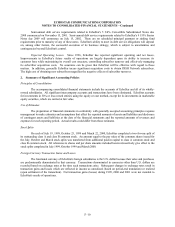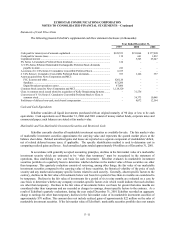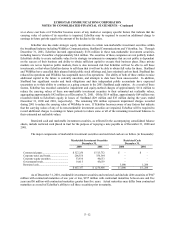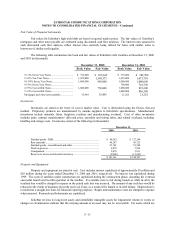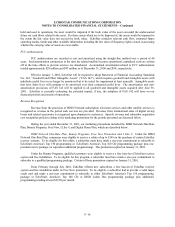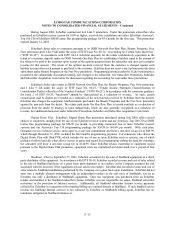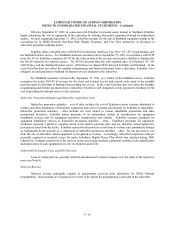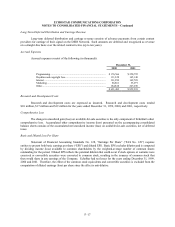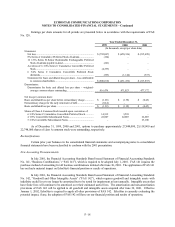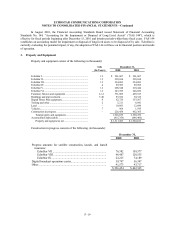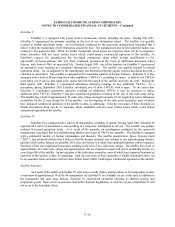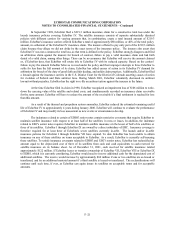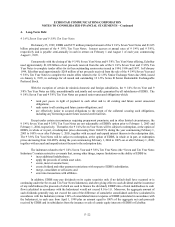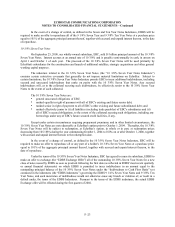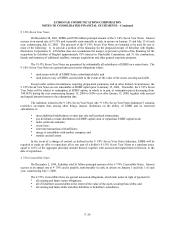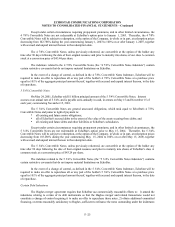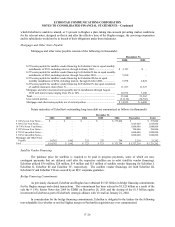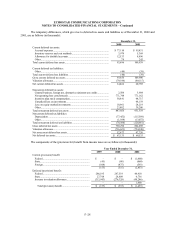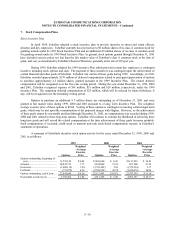Dish Network 2001 Annual Report Download - page 85
Download and view the complete annual report
Please find page 85 of the 2001 Dish Network annual report below. You can navigate through the pages in the report by either clicking on the pages listed below, or by using the keyword search tool below to find specific information within the annual report.ECHOSTAR COMMUNICATIONS CORPORATION
NOTES TO CONSOLIDATED FINANCIAL STATEMENTS – Continued
F–20
EchoStar V
EchoStar V is equipped with a total of three momentum wheels, including one spare. During July 2001,
EchoStar V experienced an anomaly resulting in the loss of one momentum wheel. The satellite was quickly
restored to normal operations mode. An investigation conducted by the spacecraft manufacturer concluded that a
failure within the momentum wheel electronics caused the loss. The manufacturer also believes that the failure was
isolated to this particular unit. While no further momentum wheel losses are expected, there can be no assurance
future anomalies will not cause further losses which could impact commercial operation of the satellite. At
EchoStar’s request, the manufacturer has developed contingency plans which include modification to the
spacecraft’s on-board software that will allow continued operation in the event of additional mometum wheel
failures, with limited effect on spacecraft life. During August 2001, one of the thrusters on EchoStar V experienced
an anomalous event resulting in a temporary interruption of service. The satellite was quickly restored to normal
operations mode. An investigation by the manufacturer has determined that the engine remains functional but with a
reduction in rated thrust. The satellite is equipped with a substantial number of backup thrusters. EchoStar V is also
equipped with a total of 48 traveling-wave-tube amplifiers (“TWTAs”), including 16 spares. A total of two TWTAs
were taken out of service and replaced by spares between the launch of the satellite and June 30, 2001. During the
third quarter 2001, EchoStar V experienced anomalous telemetry readings on two additional TWTAs. As a
precaution, during September 2001 EchoStar substituted one of those TWTA’s with a spare. To the extent that
EchoStar V experiences anomalous telemetry readings on additional TWTAs it may be necessary to utilize
additional spare TWTAs. EchoStar V has also experienced anomalies resulting in the loss of one solar array string.
The satellite has a total of approximately 96 solar array strings and approximately 92 are required to assure full power
availability for the 12-year design life of the satellite. An investigation of the solar array anomalies, none of which
have impacted commercial operation of the satellite to date, is continuing. Until the root cause of these anomalies is
finally determined, there can be no assurance future anomalies will not cause further losses which could impact
commercial operation of the satellite.
EchoStar VI
EchoStar VI is equipped with a total of 48 transponders, including 16 spares. During April 2001, EchoStar VI
experienced a series of anomalous events resulting in a temporary interruption of service. The satellite was quickly
restored to normal operations mode. As a result of the anomaly, an investigation conducted by the spacecraft
manufacturer concluded that one stationkeeping thruster and a pair of TWTA are unusable. The satellite is equipped
with a substantial number of backup transponders and thrusters. The satellite manufacturer, Space Systems Loral
(“SS/L”), has advised EchoStar that it believes that the thruster anomaly was isolated to one stationkeeping thruster,
and that while further failures are possible, SS/L does not believe it is likely that additional thrusters will be impacted.
EchoStar VI has also experienced anomalies resulting in the loss of two solar array strings. The satellite has a total of
approximately 112 solar array strings and approximately 106 are required to assure full power availability for the 12-
year design life of the satellite. An investigation of the solar array anomalies, none of which have impacted commercial
operation of the satellite to date, is continuing. Until the root cause of these anomalies is finally determined, there can
be no assurance future anomalies will not cause further losses which could impact commercial operation of the satellite.
Satellite Insurance
As a result of the failure of EchoStar IV solar arrays to fully deploy and the failure of 30 transponders to date,
a maximum of approximately 14 of the 44 transponders on EchoStar IV are available for use at this time. In addition to
the transponder and solar array failures, EchoStar IV experienced anomalies affecting its thermal systems and
propulsion system. There can be no assurance that further material degradation, or total loss of use, of EchoStar IV will
not occur in the immediate future.


